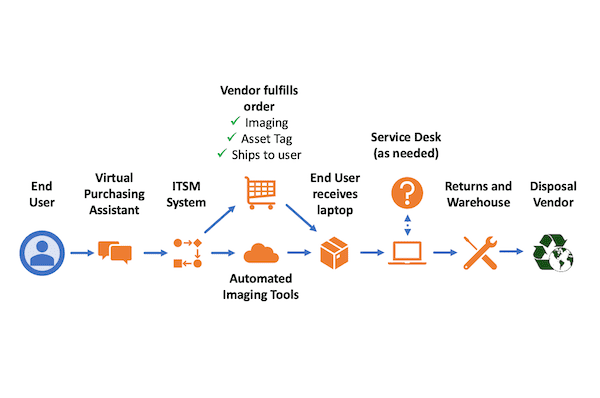
Over the years, our series of Best Practices guides have proven to be some of our most popular resources. Among those, our Asset Lifecycle Management best practices guide had the most downloads. This month, we are launching an all-new, slightly renamed version of this popular document called Best Practices Guide: IT Asset Management. It explains how next-generation, automated IT asset management systems can support 100% remote workforces given the disruption in the IT asset management lifecycle brought on by the global pandemic. Organizations must effectively adapt their processes to support a business-to-consumer model.
All well-run IT organizations need a cost-effective and scalable system for acquiring, deploying, monitoring, maintaining, upgrade, and retiring IT assets. Known as IT Asset Management or ITAM, these systems maximize the value organizations receive from assets that can represent up to 50% or your total assets or 80% of your capital purchases.
Traditionally, ITAM has required large teams focused on functions such as Logistics, Provisioning, New Hires, Vending Machine Support, Inventory Management, Donation Support, E-Waste, and EOL Refresh. These teams required significant headcount and substantial warehouse space. Manually performing these functions was very labor-intensive and expensive. But it was needed to achieve the necessary levels of asset visibility, control, value, and inventory optimization.
The Best Practices for IT Asset Management Have Changed
This old, labor-intensive model of IT Asset Management is now obsolete. Using modern automation techniques, it is now possible to deploy and operate large-scale IT asset management systems where no IT resource physically touches an employee’s device until it needs a hardware repair or reaches the end of its life. Procurement, imaging, deployment, software provisioning, ongoing support, reverse logistics, and other functions occur via automated systems or vendors. At Milestone, we call this capability Near Zero Touch IT asset management. It is the future of IT asset management.
Near Zero Touch works by organizing the IT asset management work into six basic steps:
- Collaborative procurement, where the end-user interacts with an AI-based intelligent purchasing assistant to order a new device
- Workflow Orchestration, where automated systems process the order and submit it to a fulfillment vendor
- Zero Touch Imaging, where a vendor prepares the device and ships it directly to the end-user
- Device Reception, where the end-user receives the device, plugs it in, and has all their software automatically downloaded and configured
- Troubleshooting, where if necessary, AI-based virtual service desk agents and human agents work with the user to resolve problems
- End of Life dispositioning, where the user returns the device to corporate.
Are you wondering where the ‘near’ comes from in the name? With one of these systems fully deployed, IT workers typically will never need to physically touch an end user’s device until either the user returns it to corporate for a hardware repair or the device has reached its End of Life. That’s pretty near zero touch.
Benefits Include Support for 100% Remote Workforces
Next-generation automated IT asset management provides several significant advantages over traditional IT asset management, including:
- Support for 100% remote workforces, both end-users and most IT workers. Remote means anywhere – from home, a hotel, at a field office, at a customer site, etc. Of course, workers can also be working in the office. Furthermore, work locations can change over time as situations warrant
- A superior employee experience via reduced lead times to receive new devices and status alerts at all stages of the workflow
- Dramatically lower labor, inventory and warehouse costs
- Superior visibility and accountability for all assets through all lifecycle stages
At Milestone, we help our clients implement best practices IT Asset Management as a managed service and by consulting with them on building their own systems. If you are interested in finding out more about next-generation IT Asset Management, download our Best Practices Guide: IT Asset Management.




